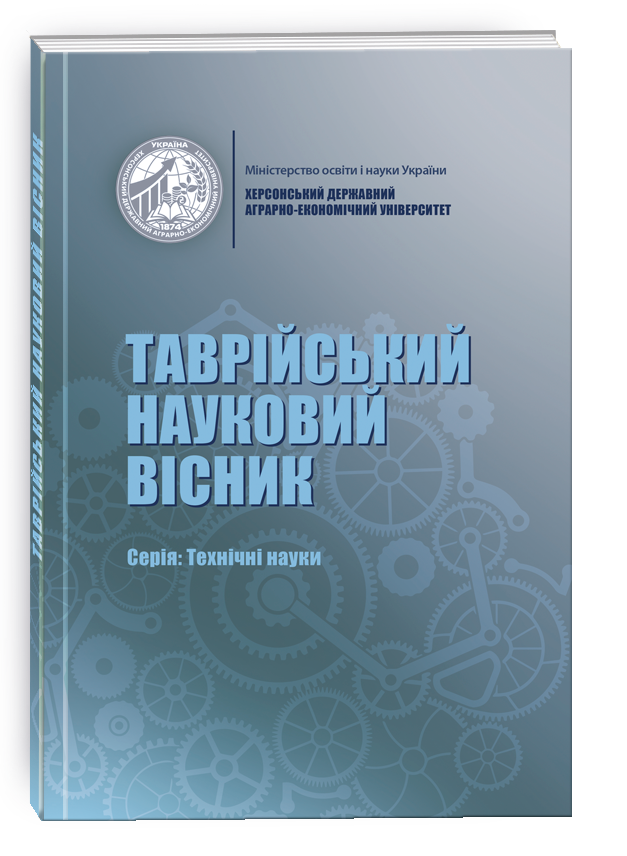DEVICE FOR REGULATION WATER-THERMAL REGIME OF SOILS
DOI:
https://doi.org/10.32782/tnv-tech.2023.2.26Keywords:
soil, root layer, water-thermal regime, agricultural crops, temperature gradient, irrigator-heaterAbstract
The paper presents the results of research on the possibility of compensating for the lack of thermal in the soil due to its forced supply to the estimated soil layer and ensuring the necessary water- thermal regime to create comfortable conditions for the vegetation of agricultural plants. The results of research known in hydrotechnical practice, aimed at solving the problem of creating the necessary water-thermal regime of the soil for the conditions of the steppe zone of Ukraine, were analyzed. It has been proved that for the conditions of the studied territory of the Black Sea Lowland, the water and thermal regimes of the soil are interrelated, especially in the root layer. To develop the idea of complex regulation of the water-thermal regime of soils, a theoretical justification of technical solutions was performed, which considers the movement of water in the system soil – plant – atmosphere. It was established that the occurrence of moisture flow when a temperature gradient is imposed shows that a relatively small temperature difference is enough to cause water movement in the soil, especially in a limited space. Therefore, the creation of an increased temperature difference along the depth of the soil profile allows you to speed up the provision of the necessary water and thermal regime. As a result of the research, a device was developed that can be used to irrigate crops and protect the soil from freezing. The design of the device for regulating the water- thermal regime of the soil, which was called the irrigator-heater according to the declaratory patent of Ukraine No. 20031211944 of one of the authors, was considered. The use of the proposed device allows you to reduce the costs of irrigation of agricultural crops, due to 60 % saving of irrigation water and significantly reduce operational costs.
References
Воропай Г.В., Яцик М.В., Мозоль Н.В. та ін. Особливості формування водно-теплового режиму осушуваних ґрунтів в умовах змін клімату. Вісник аграрної науки. 2020. № 1 (802). С. 68–74.
Кузьмич Л.В., Коваль С.І. Аналіз природно-кліматичних та антропогенних чинників, що впливають на екологічну безпеку осушуваних торфових ґрунтів. Науковий вісник. 2009, Вип. 19. С. 214–218.
Лозовіцький П.С. Меліорація ґрунтів та оптимізація ґрунтових процесів : підручник. 2014. 528 с.
Ладичук Д.О., Сафонова О.П. Критерії оцінки родючості агроландшафтів півдня України в сучасних умовах землекористування. Вісник Харківського національного аграрного університету. 2004. № 1. С. 147–151.
Теплові властивості грунтів. URL: http://www.geograf.com.ua/ gruntoznavstvo/1008-teplovi-vlastivosti-gruntiv
Jin C.X., Sands G.R., Kandel H.J. et al. Influence of Subsurface Drainage on Soil Temperature in a Cold Climate. J. of Irrigation and Drainage Engineering. February. 2008. V. 134. Р. 83–88.
Смага І.С., Черлiнка В.Р., Дмитрук Ю.М. Землеробство. Фактори життя рослин і родючість ґрунту : навч. посібник. Чернівці, 2022. 128 с.
Врублевська О.О., Катеруша Г.П. Кліматологія: Конспект лекцій. Одеса, 2011. 140 с.
Рижук С.М., Кочик Г.М., Мельничук А.О. та ін. Стратегічне управління продуктивністю агроценозів у системі осушуваного землеробства. Вісник аграрної науки. 2022. № 7 (832). С. 62–74.
Школьний Є.П. Фізика атмосфери: Підручник. Одеса, 2005. 507 с.
Philip G.R., de Vries D.A. Moisture movement in porous materials under temperature gradients. Amer. Geophys. Union Transactions. 1957. V. 38. Р. 222–232.
Деклараційний патент на винахід 72710 А, Україна, МКІ. Зрошувач-нагрівач. / Д.О. Ладичук, О.І. Булигін. № 20031211944. Заявл. 19.12.2003 ; Опубл. 15.03.2005, Бюл. № 3. 2с.







